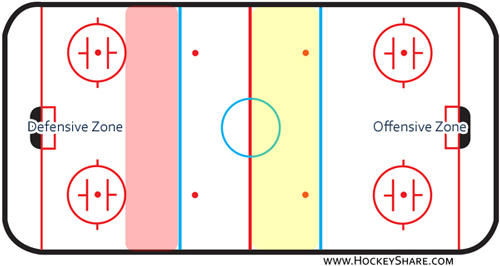Crucial Areas of the Ice
Those of us near the Chicago area are lucky to get Eddie Olczyk’s analysis of the Chicago Blackhawks games on a regular basis. In my opinion, he does a great job of breaking the game down and analyzing important plays. Any player (or coach) who watches games he’s announcing can take lots of great tidbits and apply them directly to their own game. In last night’s Olympic matchup between the USA and Canada, Eddie O pointed out the key areas for USA in the last minutes of the game. The areas he mentioned are simple, but important. I thought it was a great opportunity to cover what he said, and expand on it further.

The areas shown above are important not only to hold on to a lead in the last fading minutes of a game, but also when you’re in a tight game. Turn-overs in these areas lead to good scoring opportunities for the opponent and open up holes in your defensive coverage.
The first area in red shows the area from the top of the circle to the blue line in the defensive zone. If a player gets the puck in this zone, the puck MUST get out of the zone. There are usually three options for this: 1) Pass 2) Off the Glass 3) Ice the Puck.
Turn-over threat: Turn-overs in this area often lead to offensive players skating to leave the zone (to attack). With this, they are most times releasing from their defensive zone responsibility. If your center’s defensive responsibility is a man down low, and they’ve left the zone already, a quick shot on net from the opposing defense will lead to an odd-man situation in front of the net.
Benefit to executing: The best-case scenario is you control the puck out of the zone and are able to get the puck in deep or create a scoring opportunity. Worst-case, you’ve bought yourself and teammates a few seconds to regroup and defend the return rush. Since it is highly likely the opposing team will take a few seconds to exit the zone, players should have sufficient time to re-identify their coverage.
The second area in yellow shows the offensive-side of the neutral zone. In this area, players must make sure the puck gets deep. They can either skate the puck in if they have time/space, or they can dump it in.
Turn-over threat: If the puck fails to get deep in this zone, it becomes much more difficult for defensemen to get adequately set for the rush. If the D are following the play up ice, they will have to transition before they can play the rush effectively. If the defensemen were caught deep in the d-zone and are still trying to get out, their gap will be large, which will give the attacking forwards a lot of time and space. If the D are changing lines, they will have to hustle from a side-position to get back to the middle of the ice. None of these situations are ideal – especially when playing with a lead.
Benefit to executing: There are several benefits to getting the puck in deep: 1) Tired lines can change 2) Eats up time on the clock 3) Allows attacking players to set up a proper forecheck 4) Scoring opportunities.
This is NOT to say players shouldn’t ever try to be creative and try new moves or different plays in these areas. These are simply rules to help be effective when playing in a tight game – especially with a lead in the last few minutes. It is in these times where small mistakes and turn-overs are greatly magnified. Remember – don’t get too mad when your players don’t execute properly. The “best of the best” still make mistakes in these areas…in fact, our game would be extremely boring if they didn’t!
